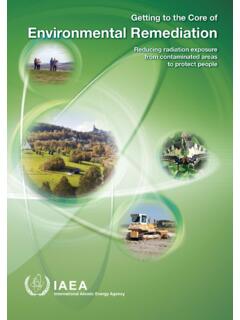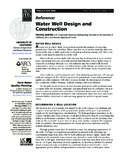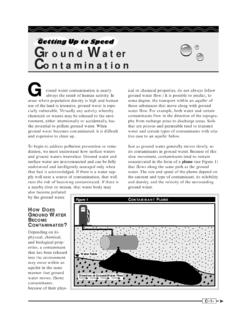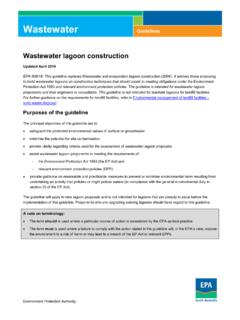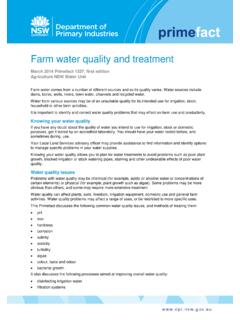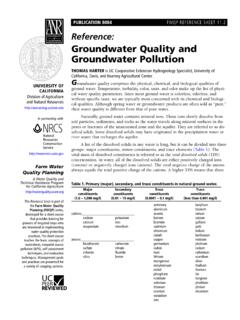Transcription of PROCEDURES AND REQUIREMENTS FOR THE DISCHARGE OF …
1 PROCEDURES AND REQUIREMENTS FOR. THE DISCHARGE OF WASTEWATER. Who Should Read This Guidance This guidance document has been prepared for Project Managers, Facilities Operations and Maintenance personnel, and other University personnel who may initiate or perform the DISCHARGE of wastewater. This document gives the REQUIREMENTS for all DISCHARGE of wastewater at Yale University and describes wastewater DISCHARGE pathways, wastewater categories, DISCHARGE limitations, and permit REQUIREMENTS . Why This Is Important Virtually all wastewater discharges require a DISCHARGE permit issued by the Connecticut Department of Environmental Protection ( CTDEEP ), usually requiring a permit application or registration.
2 Contact Environmental Health & Safety as soon as any project anticipates requiring a wastewater permit. EHS. will coordinate and facilitate this process. What Is Wastewater Wastewater is water that has been changed in some way and is no longer suitable, or there are no means for reuse, and requires disposal or DISCHARGE . An on-line training module on this topic is available and recommended for affected personnel. Additional REQUIREMENTS for DISCHARGE of wastewater from laboratory operations are covered in Appendix F of the Chemical Waste Management manual.
3 Water can pick-up pollutants, be changed thermally (hotter or colder), have pH changed, or become more concentrated in minerals, such as from evaporation or purification. Examples of pollutants include: Human wastes (domestic sewage). Fats, Oils & Grease ( FOG ). Food preparation waste Toxic and poisonous substances Metals from process or picked up from piping Acidic or basic compounds Malodorous compounds ( formaldehyde, mercaptans). Radioactive substances Suspended and dissolved solids (biodegradable and non-biodegradable). Materials with high oxygen demand (to biodegrade).
4 Biological substances Wastewater DISCHARGE Pathways There are three main pathways that wastewater can be discharged to: TO SANITARY SEWER. to the sewage treatment plant. This is often referred to as a Publically Owned Treatment Works ( POTW ). In New Haven the Greater New Haven Water pollution Control Authority ( GNHWPCA ) manages the sanitary sewer system and the sewage treatment plant. The West Campus sanitary sewer system drains to the West Haven Water Pollution Control Facility ( WHWPCF ). TO A SURFACE WATER. (such as a pond, stream, river, harbor or ocean), either directly or to a storm drain that is connected to a separate storm sewer system.
5 In some areas of New Haven, storm drains are combined with sanitary sewers and lead to the POTW. New Haven is in the process of separating these types of sewers. Stormwater DISCHARGE to surface water TO THE GROUND. Ground surface DISCHARGE infiltrates through the soil to groundwater , or sub-surface (sometimes called underground injection) can DISCHARGE directly to underground aquifers. Note DISCHARGE to hard-packed surfaces can run-off and eventually DISCHARGE to surface waters. Roof drain DISCHARGE to ground The Federal Clean Water Act and its subsequent amendments first set limits on DISCHARGE of wastewater pollutants, and established permit programs.
6 In Connecticut, all wastewater discharges to sanitary sewer, surface water, and to the ground require a permit from the Connecticut Department of Energy & Environmental Protection. DISCHARGE to Sanitary Sewer Most wastewaters are required to be discharged to the sanitary sewer, so pollutants can be removed by the POTW prior to DISCHARGE to surface water. Treatments include flocculation, settling, filtration, biological treatment, and disinfection. The POTW then discharges the water under its own surface water DISCHARGE permit. Treatment residue sludge must also be disposed of, usually by incineration; this imposes further restrictions on the type and quantity of wastewater pollutants.
7 Typical POTW layout Typical Water Pollution Control Facility Treatment Process An interactive presentation of typical wastewater treatment (Adobe Flash required). For these reasons, sewer ordinances based on federal law further set limits on DISCHARGE to the POTW. No DISCHARGE may for any reason cause, either singly or in combination with other discharges: Interference with or adverse effect upon the operation of the POTW;. Interference with or adverse effect upon the POTW's sludge handling, use, or disposal;. The POTW to exceed its influent design loading parameters.
8 The POTW to violate its permit, including but not limited to exceeding its permit limits;. A worsening of any condition which is causing the POTW to exceed its influent design loading parameter or violate its permit;. Pass through any substance into the receiving waters which causes or threatens pollution;. No DISCHARGE to a POTW may contain: Any substance which causes or threatens a fire or explosion hazard in the POTW;. Any substance which causes or threatens corrosive structural damage to the POTW. In no case shall a substance with a pH less than be discharged unless the POTW.
9 Is specifically designed to accommodate such a DISCHARGE (GNHWPCA requires a pH. of to , WHWPCF requires a pH of no less than to state permit pH high limit;. Solid or viscous wastes in amounts which cause or threaten obstruction to flow in the sewers;. Heat in such amounts that the temperature of the POTW influent exceeds F, unless the POTW is designed to accommodate such heat. DISCHARGE to Surface Water Some wastewaters containing minimal levels of pollution may be discharged directly to surface waters, or to storm drains leading to separate storm sewer systems.)
10 This includes stormwater run-off, certain non-contact cooling waters, certain hydrostatic pressure-testing water, and non-chlorine containing swimming pool draining waters. Yale surface water discharges are mostly limited to stormwater run-off to storm drains. For further stormwater information, including construction stormwater permitting REQUIREMENTS , please review our Stormwater Best Management Practices policy. DISCHARGE to Ground Some wastewaters can be discharged to the ground, which actually provides some filtering and cleaning of the water, and in some cases is preferable to surface water discharges.









